| 6 July |
• yesterday • tomorrow |
| Optional Memorial of Saint Maria Goretti, Virgin and Martyr |
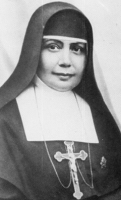
• Nazaire de Sainte-Thérèse March Mesa
• Nazaria Ignacia de Santa Teresa de Jesus
Fourth of eighteen children born to José Alejandro March y Reus, a merchant, fisherman and industrial worker, and Nazaria Mesa Ramos; Nazaira had a twin sister, Ignazia, and ten brothers who survived infancy. She and her sister were baptized on the day they were born, Nazaria made her First Communion on 21 November 1898 and made a personal vow of consecration to God. Unlike many children who are drawn to religious life at an early age, her family was indifferent to the faith, and grew so tired of her of her devotions that they once "grounded" her from going to Mass. By the time she was confirmed on 15 March 1902, which was celebrated by Blessed Marcelo Spínola y Maestre, her family had grown used to her piety, and allowed her to join the Franciscan Third Order and more actively practice her faith. She succeeded in getting several of them to return to the Church.
In late 1904, business failures led the family to move to Mexico. On the trip, Nazarie met sisters in the Instituto de Hermanitas de los Ancianos Desamparados (Institute of Sisters of the Abandoned Elders), and was so inspired by their charism that on 7 December 1908 she followed a calling to religious life, and entered the Institute in Mexico City, Mexico; she made her perpetual vows on 1 January 1915, and took the name Sister Nazaire de Sainte-Thérèse. Her diaries of the time show a deep devotion to her calling, but struggles with her vows of obedience to her superiors.
She was assigned to the Institute hospice in Oruro, Bolivia where she worked as a cook, housekeeper, nurse and occasional beggar to support the poor and neglected for twelve years. The region around Oruro was not entirely Christian, many Protestant groups were establishing missions, and the few priests in the area were often lax or lived scandalous lives. Beginning in 1920 Sister Nazaire began to feel a call to found a new congregation devoted to missionary work, evanglization and religious education. On 18 January 1925, the feast of the Chair of Saint Peter, Sister Nazaire made a special vow of obedience to the Pope, and on Pentecost that year she made a vow to work for the union and extension of the Holy Catholic Church. On 16 June 1925, with six other sisters, she founded the Pontifical Crusade, later renamed the Congregation of the Missionary Crusaders of the Church, and began service as their superior. The mission of the Congregation was to catechize children and adults, support the work of priests, conduct missions, and to print and distribute short religious tracts.
Mother Nazaire met with opposition to her work, much of it from within Church administration. Her sisters in the Institute treated her as a traitor to her original vocation for turning away from their work; her superiors considered her disobedient, and some Claretian clergy considered her a glory-hound, ignoring all the help members of their order had given her. But Nazaire clung to Christ and pressed on.
Monsignor Felipe Cortesi, while in Bolivia, had worked to help Mother Nazaire to found the Congregation. When he was assigned to be the apostolic nuncio of Argentina in 1930, he asked had her open a Missionary Crusader house in Buenos Aires. The Congregation received an early test under fire during the 1932 to 1935 war between Bolivia and Paraguay; Mother Nazaire and the sisters cared for and brought the sacraments to soldiers on both sides, and helped establish homes for war orphans. In 1934 she founded the first magazine in Bolivia for women in religious life, Al Adalid de Cristo Rey, and the first female trade union, Sociedad de Obrera Católicas
In early 1934, Monsignor Cortesi asked the Vatican Congregation of Religious to approve the rules for the Crusaders that Nazaire had written, based on Ignatian spirituality. Later that year, Mother Nazaria travelled to Rome with an Argentinian pilgrimage group to work for the approval of her Rule. She made pilgrimages to several sites, and had a private audience with Pope Pius XI during which Nazaire said that she was willing to die for the Church; the Pope told her that she must, instead, live and work for the Church.
Leaving Italy for her native Spain, Mother Nazaire founded a retreat center for spiritual exercises in Madrid under the flag of Uruguay; the sisters there survived the Spanish Civil War as Franco did not wish to risk the international incident killing them would cause. With the help of the Bolivian government, Mother Nazaria was able to leave the persecutions in Spain and return to the Americas. She summoned a general chapter of the Congregation in 1937 to strengthen the unity and zeal of her sisters. Worked on the spiritual formation of new sisters, and set an example by her pious, simple life. To the superiors of the Congregation houses she always recommended a maternal approach to the sisters in their care, to remember their role as Mother of the house. When the Spanish Civil War ended, Nazaire returned to Spain to check on the sisters she had left behind, then returned to the Americas for the final time. The Congregation spread throughout South America and began to work in Portugal, Spain, France, Italy and Camaroon. Though Nazaire did not live to see it, the Congregation received Vatican recognition on 9 June 1947 by Pope Pius XII.
10 January 1889 at Arcos de Santa María N° 41 (Augusto Figueroa), Madrid, Spain
• 6 July 1943 in the Rivadavia Hospital, Buenos Aires, Argentina of complications from pneumonia and tuberculosis
• buried in the Chacorita cemetery in Buenos Aires on 8 July 1943
• relics re-interred at the Congregation house at Buenos Aires on 14 June 1957
• relics enshrined in the crypt of the mother house of the Congregation in Oruro, Bolivia in 1972
27 September 1992 by Pope John Paul II in Saint Peter's Basilica, Rome, Italy
on 26 January 2018, Pope Francis promulgated a decree of a miracle attributed to the intercession of Blessed Nazaria
Missionary Crusaders of the Church
https://catholicsaints.info/blessed-nazaria-ignacia-march-y-mesa/

Beautiful, pious farm girl, one of six children of Luigi Goretti and Assunta Carlini. In 1896 the family moved to Ferriere di Conca. Soon after, Maria's father died of malaria, and the family was forced to move onto the Serenelli farm to survive.
In 1902 at age twelve, Maria was attacked by 19-year-old farm-hand Alessandro Serenelli. He tried to rape the girl who fought, yelled that it was a sin, and that he would go to hell. He tried to choke her into submission, then stabbed her fourteen times. She survived in hospital for two days, forgave her attacker, asked God's forgiveness of him, and died holding a crucifix and medal of Our Lady. Counted as a martyr.
While in prison for his crime, Allessandro had a vision of Maria. He saw a garden where a young girl, dressed in white, gathered lilies. She smiled, came near him, and encouraged him to accept an armful of the lilies. As he took them, each lily transformed into a still white flame. Maria then disappeared. This vision of Maria led to Alessandro's conversion, and he later testified at her cause for beatification.
16 October 1890 at Corinaldo, Ancona, Italy
• choked and stabbed to death during a rape attempt on 6 July 1902 at the age of 12 at Nettuno, Lazio, Italy
• buried in the crypt of the Basilica of S. Maria delle Grazie e S. Maria Goretti, Nettuno
• 24 June 1950 by Pope Pius XII
• the ceremony was attended by 250,000 including her mother, the only time a parent has witnessed her child's canonization
• against poverty
• against the death of parents
• children
• girls
• martyrs
• poor people
• rape victims
• young people in general
• Children of Mary
• diocese of Albano, Italy
• Albano Laziale, Italy (proclaimed on 5 May 1952 by Pope Pius XII)
• Latina, Italy
It is well known how this young girl had to face a bitter struggle with no way to defend herself. Without warning a vicious stranger burst upon her, bent on raping her and destroying her childlike purity. In that moment of crisis she could have spoken to her Redeemer in the words of that classic, The Imitation of Christ: "Though tested and plagued by a host of misfortunes, I have no fear so long as your grace is with me. It is my strength, stronger than any adversary; it helps me and give me guidance." With splendid courage she surrendered herself to God and his grace and so gave her life to protect her virginity. The life of a simple girl - I shall concern myself only with highlights - we can see as worthy of heaven. Even today people can look upon it with admiration and respect. Parents can learn from her story how to raise their God-given children in virtue, courage, and holiness; they can learn to train them in the Catholic faith so that, when put to the test, God's grace will support them and they will come through undefeated, unscathed, and untarnished. From Maria's story carefree children and young people with their zest for life can learn not to be led astray by attractive pleasures which are not only ephemeral and empty but also sinful. Instead they can fix their sights on achieving Christian moral perfection, however difficult that course may prove. With determination and God's help all of us can attain that goal by persistent effort and prayer. Not all of us are expected to die a martyr's death, but we are all called to the pursuit of Christian virtue. So let us all, with God's grace, strive to reach the goal that the example of the virgin martyr, Saint Maria Goretti, sets before us. Through her prayers to the Redeemer may all of us, each in his own way, joyfully try to follow the inspiring example of Maria Goretti who now enjoys eternal happiness in heaven. - from a homily by Venerable Pope Pius XII at the canonization of Saint Maria Goretti
https://catholicsaints.info/saint-maria-goretti/
• Thomas Aufield
• Thomas Alphilde
• Thomas Hawfield
• Thomas Offeldus
• Thomas Badger
29 October as one of the Martyrs of Douai
Educated at Eton and King's College, Cambridge, obtaining his degree in 1568. Raised Protestant, he converted as an adult to Catholicism. Entered the seminary at Douai and Rheims, France in 1576. Ordained in 1581. Returned to England to minister to covert Catholics during a period of persecution, working in the north. Arrested, tortured and sent to the Tower of London on 2 May 1582, he renounced his conversion to Catholicism, expressed a desire to return to the Protestant church, and was released. Riddled with guilt over his failure to keep the faith, he returned to Rheims, returned to the Church, and then returned to England. Arrested again, he was sent back to the Tower, then to Newgate prison, then condemned for treason, and executed for the crimes of priesthood and distributing the booklet True and Modest Defense, a defense of the faith. Martyr.
Gloucester, England
hanged, drawn and quartered on 6 July 1585 at Tyburn, London, England
15 December 1929 by Pope Pius XI
https://catholicsaints.info/blessed-thomas-alfield/
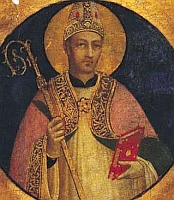
Romolo di Fiesole
Converted by Saint Peter the Apostle, he preached throughout central Italy, and served as first bishop of Fiesole, Italy. Martyred with Carissimus, Dulcissimus, and Crescentius by order of governor Repertian in the persecutions of Emperor Domitian.
Later popular fictions describes him as the illegitimate son of Lucerna and her father's slave Cyrus, that he was abandoned as an infant, suckled by a wolf, and captured by Saint Peter when Emperor Nero was unable to do so. The story says that after his conversion, and extensive training by Peter and his assistant Justin, Romulus performed extravagant miracles. Though popularly reported, it's all fiction.
martyred c.90
Fiesole, Italy
• being martyred with the three companions
• bishop with an arrow broken above his breast
• enthroned with his fellow martyrs
https://catholicsaints.info/saint-romulus-of-fiesole/

• Dominica of Tropea
• Ciriaca of...
Daughter of Doroteo and Arsenia. Martyred in the persecutions of Diocletian for destroying pagan idols.
287 in Tropea, Calabria, Italy
• she was thrown to wild animals, but they would not harm her
• beheaded 6 July 303 in Nicomedia, Bithynia (in modern Turkey)
• relics interred in Vizzini, Italy
• relics enshrined in the cathedral in Tropea, Calabria, Italy
• Pre-Congregation
• the Sacred Congregation of Rites granted a special Mass in her honour to Tropea, Calabria, Italy on 14 May 1672
• Camaldoli, Italy
• Caraffa di Catanzaro, Italy
• Mandanici, Italy
• Scorrano, Italy
• Torre di Ruggiero, Italy
• Tremestieri, Italy
• Tropea, Italy
https://catholicsaints.info/saint-dominica-of-campania/
• Palladius of Aberdeen
• Palladius of Scotland
• Pallade, Palladio
• Apostle of the Scots
Born to an ancient Gallo-Roman family. Deacon in Rome. Dispatched Saint Germanus of Auxerre to Britain in 429 to fight Pelagianism. Missionary bishop for Ireland in 431, sent by Pope Saint Celestine I. Consecrated bishop of the Scots in 431. Evangelized around Leinster where he built three churches, converted some people, and faced strong opposition. He decided that the Irish were not truly ready to receive message, and took his work to Scotland. Founded churches at Kelleen Cormac, Tigroney, and Donard. Began evangelizing the Picts, but died soon after. His story was written by Saint Prosper of Aquitaine.
• 432 at Fordun, Scotland of natural causes
• buried at the monastery at Fordun, Aberdeen, Scotland
• relics enshrined in a jewel encrusted sarcophagus in 1409
Scotland
https://catholicsaints.info/saint-palladius-of-ireland/
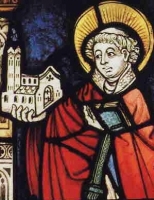
Priest. In 519, to serve God anonymously, he migrated to the area around Trier, Germany, and became a hermit in a cell at Oberwesel on the Rhein. Well known for sanctity, prophecies, and miracles. Refused the archbishopric of Trier. Charlemagne built a stately church over Goar's hermitage, around which the town of Saint Guvet grew on the left bank of the Rhine between Wesel and Boppard.
in Aquitaine (part of modern France)
c.575
• hotel keepers, innkeepers
• potters
• vine growers
• hermit being given milk by hinds
• hermit with the devil on his shoulder
• hermit with the devil under his feet
• hermit with three hinds near him
• man hanging his hat on a sunbeam
• man holding a pitcher
• man holding the church of Saint Goar am Rhein
https://catholicsaints.info/saint-goar-of-aquitaine/

Born to the Austrian noblity, the daughter of Count Anton Ledóchowski and Josephine Salis-Zizers, known as extremely religious people. When Maria's father died of smallpox when she was 22, she turned to God for answers and began the spiritual move that would define the rest of her life. She devoted herself to supporting missionaries and fighting against slavery, writing, publishing, travelling, speaking and fund-raising endlessly. Founder of the Missionary Sisters of Saint Peter Claver.
24 April 1863 in Loosdorf, Melk, Austria
6 July 1922 in Rome, Italy of natural causes
19 October 1975 by Pope Paul VI
https://catholicsaints.info/blessed-maria-theresia-ledochowska/
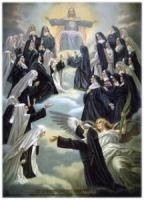
• Maria Rosa de Loye
• Marie Rose Deloye
• Mary Rose de Loye
• Susanna-Agatha de Loye
Benedictine nun at Caderousse in 1762, taking the name Mary Rose. Expelled from the convent, imprisoned and then executed during the persecutions of the French Revolution. The first of the Martyrs of Orange.
4 February 1741 in Sérignan, Vaucluse, France as
Suzanne-Agathe Deloye
guillotined in 6 July 1794 at Orange, Vaucluse, France
10 May 1925 by Pope Pius XI
https://catholicsaints.info/blessed-suzanne-agathe-deloye/
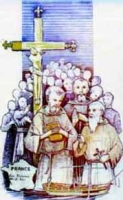
élie, Elia
Trappist monk. Imprisoned on an old ship during the anti-Catholic excesses of the French Revolution. He spent his time there caring for sick fellow prisoners. One of the Martyrs of the Hulks of Rochefort.
21 December 1750 in Hénin-Liétard, Pas-de-Calais, France
6 July 1794 of sickness and mistreatment aboard the prison ship Deux-Associés, in Rochefort, Charente-Maritime, France
1 October 1995 by Pope John Paul II
https://catholicsaints.info/blessed-augustin-joseph-desgardin/

• Baiduo
• Peter Wang Zuolong
• Pietro Wang Zuolong
Layman in the apostolic vicariate of Southeastern Zhili, China. Seized by anti-Catholic forces during the Boxer Rebellion, dragged in front of idols and ordered to renounce Christianity; he refused. Martyr.
c.1842 in Shuanzhong, Jizhou, Hebei, China
6 July 1900 in Shuanzhong, Jizhou, Hebei, China
17 April 1955 by Pope Pius XII
1 October 2000 by Pope John Paul II
https://catholicsaints.info/saint-petrus-wang-zuolung/

Sexburga, Sexburgh
Born a princess, the daughter of the King of East Anglia (part of modern England). Sister of Saint Etheldred, Saint Ethelburgh and Saint Withburgh, and half-sister of Saint Sethrid. Married to Erconbert, King of Kent (part of modern England). Mother of Saint Ermenhild and Saint Ercongotha. Founded the convent of Minster in Sheppey, England. Widowed in 664. Nun in Sheppey. Nun at the convent of Ely in 679 where she eventually became abbess.
c.635 in England
c.699 of natural causes
https://catholicsaints.info/saint-saxburgh-of-ely/

• Sisoes the Hermit
• Sisoes Magna
• Sisoe, Siso, Soses
Monk at the desert monastery of Scetis in Egypt. In 357, believing the monastery was over-crowded, he became a hermit on Mount Colzim; he chose it because it had been the mountain of Saint Anthony the Abbot; he stayed there for 70 years. Miracle worker.
Egypt
c.430 in Clisma, Egypt
https://catholicsaints.info/saint-sisoes-the-great/
Orphaned at age 10, he became an apprentice to a Turkish shoemaker. Pressured by his master to renounce Christianity and become Muslim, Cyril fled to the Chilandar monastery on Mount Athos. Eight years later he was discovered by Muslim authorities, arrested for leaving his apprenticeship, and ordered to renounce Christianity; he refused. Martyr.
burned to death in 1566 near the church of Saint Constantine in Tessaloniki
https://catholicsaints.info/saint-cyril-of-thessaloniki/
Macrina
With her sister Colombe, Macrine fled to France from Spain to escape persecutions in the 4th century. In the area of Niort, France, she and Saint Pezenne founded a small monastery. Helped convert the people of the Marais Poitevin region to Christianity.
Spain
Marais Poitevin, France
https://catholicsaints.info/saint-macrine-of-niort/

Noiala
Nun. Martyr.
beheaded at Beignan, Brittany (in modern France), date unknown
woman carrying her severed head
https://catholicsaints.info/saint-noyala-of-brittany/

Professor of Sacred Theology at the University of Paris. Mercedarian monk at the convent of Santa Maria in Toulouse, France where he was noted for his ascetic, prayerful life.
https://catholicsaints.info/blessed-christopher-solino/
Tranquillino
Father of Saint Mark and Saint Marcellian. Convert, baptized by Saint Polycarp of Rome. Priest, ordained by Pope Caius. Martyr.
stoned to death c.288 in Rome, Italy
https://catholicsaints.info/saint-tranquillinus-of-rome/
Deacon in the diocese of Le Mans, France. Pilgrim to Rome, Italy, he was murdered while travelling home.
buried in Saint-Gervais-en-Vallière, France
https://catholicsaints.info/saint-gervais/
Hermitess.
c.1243 in a monastery in Prague, Bohemia (in modern Czech Republic)
https://catholicsaints.info/blessed-angela-of-bohemia/
Darerca, Moninna, Modenna, Medana, Medan
Ascetic abbess of Sliabh Cuillin, Ireland.
518
https://catholicsaints.info/saint-monenna/
Monk in area of Condat, France.
https://catholicsaints.info/saint-giusto-of-condat/
A group of 23 Christians arrested, tortured and then beheaded together in the later 3rd century by order of governor Rictiovarus in the persecutions of Diocletian. The names that have come down to us are - Antoninus, Arnosus, Capicus, Cutonius, Diodorus, Dion, Isidore, Lucia, Lucian, Rexius, Satyrus and Severinus.
https://catholicsaints.info/martyrs-of-campania-6-july/
Five Christians martyred together in the persecutions of emperor Domitian – Carissimus, Crescentius, Dulcissimus, Marchisianus and Romulus.
c.90 near Fiesole, Italy
https://catholicsaints.info/martyrs-of-fiesole/
• Our Lady of Akita
• Attalein of Menoux
• Bertharius of Menoux
• Gredfyw
• Modwenna of Burton-upon-Trent
• Rictiovarus of Gaul
CatholicSaints.Info Portable Edition